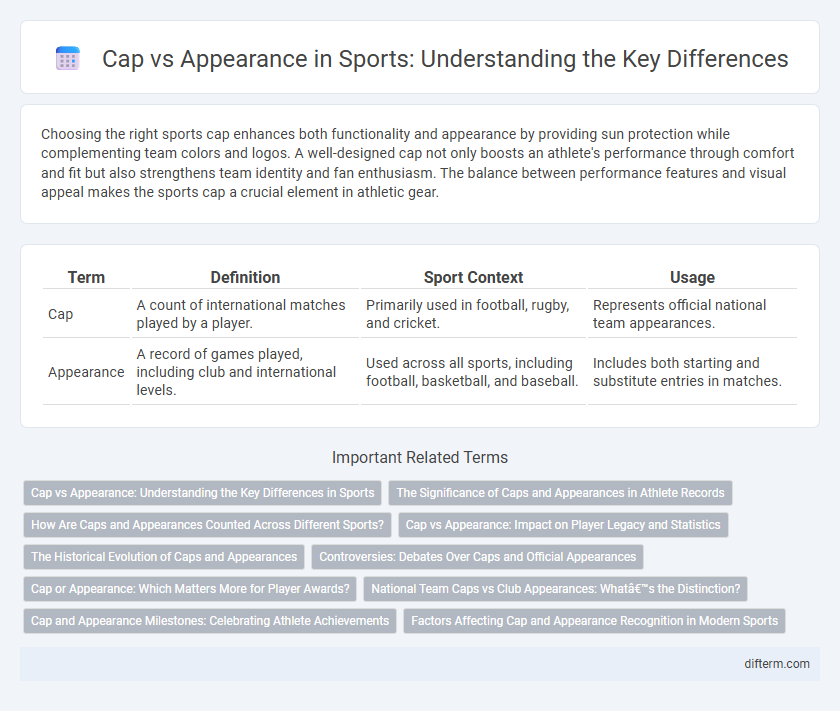Choosing the right sports cap enhances both functionality and appearance by providing sun protection while complementing team colors and logos. A well-designed cap not only boosts an athlete's performance through comfort and fit but also strengthens team identity and fan enthusiasm. The balance between performance features and visual appeal makes the sports cap a crucial element in athletic gear.
Table of Comparison
| Term | Definition | Sport Context | Usage |
|---|---|---|---|
| Cap | A count of international matches played by a player. | Primarily used in football, rugby, and cricket. | Represents official national team appearances. |
| Appearance | A record of games played, including club and international levels. | Used across all sports, including football, basketball, and baseball. | Includes both starting and substitute entries in matches. |
Cap vs Appearance: Understanding the Key Differences in Sports
In sports, a "cap" represents an official appearance a player makes for their national team, often recorded as a tally of their international matches. An "appearance," however, encompasses any game participation, whether for club or country, and may include substitute appearances not always counted as caps. Understanding the distinction helps accurately evaluate a player's experience and contribution at different competitive levels.
The Significance of Caps and Appearances in Athlete Records
Caps represent the official number of times an athlete has played for their national team, serving as a critical indicator of international experience and prestige. Appearances track the total matches played across all competitions, providing a comprehensive measure of an athlete's contribution and consistency. Together, caps and appearances offer valuable insights into an athlete's career longevity, skill level, and impact within the sport.
How Are Caps and Appearances Counted Across Different Sports?
Caps are primarily used in football (soccer) and rugby to denote the number of times a player has represented their national team in official matches, each cap corresponding to one international appearance. In cricket and basketball, the term "appearance" refers to participation in both domestic and international matches without the physical cap tradition, with statistics tracked separately for different leagues and formats. Various sports organizations maintain official records to count caps and appearances accurately, which are critical for player career milestones and eligibility criteria.
Cap vs Appearance: Impact on Player Legacy and Statistics
A cap in sports represents an official international match appearance awarded to a player, often symbolizing prestige and achievement. Appearances include all matches played, but caps specifically count recognized international games, influencing how a player's legacy is measured. The distinction between caps and general appearances affects statistical records and the evaluation of a player's contribution to national teams versus club performance.
The Historical Evolution of Caps and Appearances
Caps and appearances have long been key metrics in sports history, with caps originally signifying a player's selection for an international match, notably in football (soccer) since the 19th century. The evolution from awarding physical caps to simply recording appearances reflects the sport's professionalization and statistical emphasis over time. Today, appearances quantify a player's participation across club and international levels, while caps remain a prestigious symbol of representing one's country on the global stage.
Controversies: Debates Over Caps and Official Appearances
Disputes over the definition of caps versus official appearances frequently ignite controversy in sports statistics, particularly in football where national team selections are closely scrutinized. Some governing bodies recognize only competitive matches as cap-earning, while others include friendlies, leading to inconsistent records and debates among fans and historians. These discrepancies impact player legacies, contract negotiations, and historical comparisons within sports analytics.
Cap or Appearance: Which Matters More for Player Awards?
Caps represent a player's official international matches, while appearances include all games played, both official and unofficial. Player awards often prioritize caps because they reflect a recognized level of national team contribution and competitive performance. However, appearances can highlight experience and consistency, making the debate on which metric matters more dependent on the award criteria and context.
National Team Caps vs Club Appearances: What’s the Distinction?
National team caps represent the number of official matches a player has participated in for their country, highlighting international experience and contributions on a global stage. Club appearances denote the matches played for a player's domestic or international professional club, reflecting consistency and performance in regular league and tournament play. Understanding the distinction emphasizes the player's versatility and value, with caps demonstrating national recognition and appearances showcasing career longevity and club loyalty.
Cap and Appearance Milestones: Celebrating Athlete Achievements
Athlete achievements in sports are often highlighted through milestones such as caps and appearances, which signify the number of times a player has represented their team or country in official matches. Caps serve as an important metric in soccer, rugby, and cricket to honor player commitment and experience, while appearance milestones mark key moments that demonstrate longevity and consistent performance. Celebrating these achievements not only reflects individual dedication but also cements the athlete's legacy within their sport's history.
Factors Affecting Cap and Appearance Recognition in Modern Sports
Factors affecting cap and appearance recognition in modern sports include advancements in biometric technologies and enhanced data analytics that enable accurate tracking of player participation. Integration of artificial intelligence with performance metrics optimizes real-time identification and recording of athlete appearances across diverse sporting events. Regulatory frameworks and standardized criteria for cap allocation further influence the consistency and recognition of player achievements in competitive sports.
cap vs appearance Infographic

 difterm.com
difterm.com